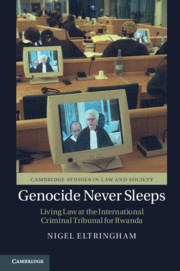Book contents
- Genocide Never Sleeps
- Cambridge Studies in Law and Society
- Genocide Never Sleeps
- Copyright page
- Contents
- Figures
- Acknowledgements
- Introduction: Judging the Crime of Crimes
- 1 ‘When We Walk Out; What Was It All About?’
- 2 ‘Watching the Fish in the Goldfish Bowl’
- 3 ‘Who the Hell Cares How Things Are Done in the Old Country’
- 4 ‘They Don’t Say What They Mean or Mean What They Say’
- 5 ‘We Are not a Truth Commission’
- Conclusion
- Bibliography
- Index
- Cambridge Studies in Law and Society
Introduction: Judging the Crime of Crimes
Published online by Cambridge University Press: 03 September 2019
- Genocide Never Sleeps
- Cambridge Studies in Law and Society
- Genocide Never Sleeps
- Copyright page
- Contents
- Figures
- Acknowledgements
- Introduction: Judging the Crime of Crimes
- 1 ‘When We Walk Out; What Was It All About?’
- 2 ‘Watching the Fish in the Goldfish Bowl’
- 3 ‘Who the Hell Cares How Things Are Done in the Old Country’
- 4 ‘They Don’t Say What They Mean or Mean What They Say’
- 5 ‘We Are not a Truth Commission’
- Conclusion
- Bibliography
- Index
- Cambridge Studies in Law and Society
Summary
Between 7 April and mid-July 1994 an estimated 937,000 Rwandans (according to a 2001 census the vast majority of whom were Tutsi), were murdered in massacres committed by militia, the gendarmerie and elements of the army, often with the participation of the local population (see Des Forges, 1999; Eltringham, 2004; IRIN, 2001). On 13 April 1994, Claude Dusaidi, the representative at the United Nations (UN) of the Rwandan Patriotic Front (the predominantly Tutsi rebel group that had entered into a power-sharing agreement with the government in August 1993), wrote to the President of the UN Security Council stating that a ‘crime of genocide’ had been committed against Rwandans in the presence of UN peacekeepers (UNAMIR1) and that the Security Council should establish a war crimes tribunal (Carlsson et al., 1999: 68).
- Type
- Chapter
- Information
- Genocide Never SleepsLiving Law at the International Criminal Tribunal for Rwanda, pp. 1 - 25Publisher: Cambridge University PressPrint publication year: 2019

